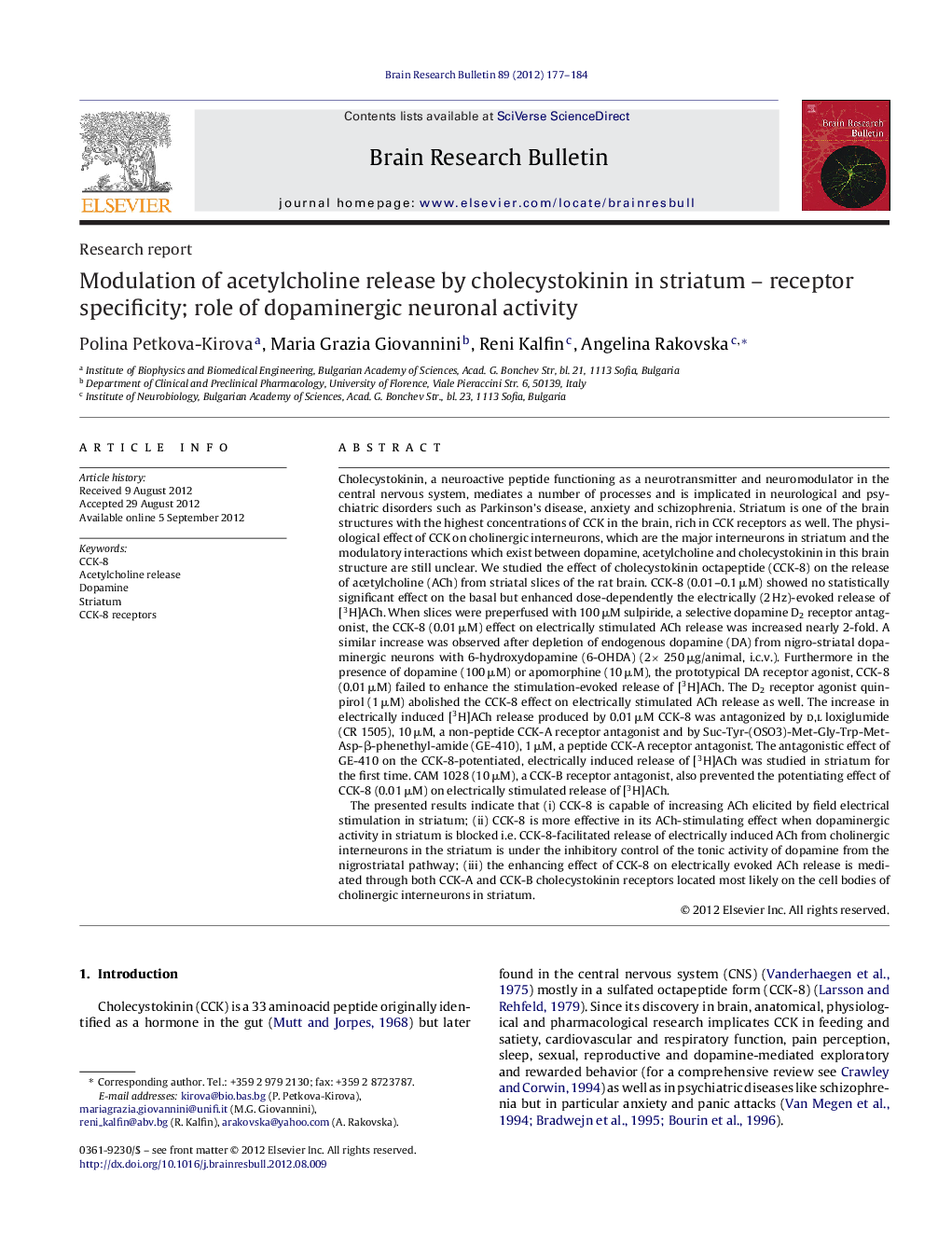| Article ID | Journal | Published Year | Pages | File Type |
|---|---|---|---|---|
| 6261915 | Brain Research Bulletin | 2012 | 8 Pages |
Cholecystokinin, a neuroactive peptide functioning as a neurotransmitter and neuromodulator in the central nervous system, mediates a number of processes and is implicated in neurological and psychiatric disorders such as Parkinson's disease, anxiety and schizophrenia. Striatum is one of the brain structures with the highest concentrations of CCK in the brain, rich in CCK receptors as well. The physiological effect of CCK on cholinergic interneurons, which are the major interneurons in striatum and the modulatory interactions which exist between dopamine, acetylcholine and cholecystokinin in this brain structure are still unclear. We studied the effect of cholecystokinin octapeptide (CCK-8) on the release of acetylcholine (ACh) from striatal slices of the rat brain. CCK-8 (0.01-0.1 μM) showed no statistically significant effect on the basal but enhanced dose-dependently the electrically (2 Hz)-evoked release of [3H]ACh. When slices were preperfused with 100 μM sulpiride, a selective dopamine D2 receptor antagonist, the CCK-8 (0.01 μM) effect on electrically stimulated ACh release was increased nearly 2-fold. A similar increase was observed after depletion of endogenous dopamine (DA) from nigro-striatal dopaminergic neurons with 6-hydroxydopamine (6-OHDA) (2à 250 μg/animal, i.c.v.). Furthermore in the presence of dopamine (100 μM) or apomorphine (10 μM), the prototypical DA receptor agonist, CCK-8 (0.01 μM) failed to enhance the stimulation-evoked release of [3H]ACh. The D2 receptor agonist quinpirol (1 μM) abolished the CCK-8 effect on electrically stimulated ACh release as well. The increase in electrically induced [3H]ACh release produced by 0.01 μM CCK-8 was antagonized by d,l loxiglumide (CR 1505), 10 μM, a non-peptide CCK-A receptor antagonist and by Suc-Tyr-(OSO3)-Met-Gly-Trp-Met-Asp-β-phenethyl-amide (GE-410), 1 μM, a peptide CCK-A receptor antagonist. The antagonistic effect of GE-410 on the CCK-8-potentiated, electrically induced release of [3H]ACh was studied in striatum for the first time. CAM 1028 (10 μM), a CCK-B receptor antagonist, also prevented the potentiating effect of CCK-8 (0.01 μM) on electrically stimulated release of [3H]ACh.The presented results indicate that (i) CCK-8 is capable of increasing ACh elicited by field electrical stimulation in striatum; (ii) CCK-8 is more effective in its ACh-stimulating effect when dopaminergic activity in striatum is blocked i.e. CCK-8-facilitated release of electrically induced ACh from cholinergic interneurons in the striatum is under the inhibitory control of the tonic activity of dopamine from the nigrostriatal pathway; (iii) the enhancing effect of CCK-8 on electrically evoked ACh release is mediated through both CCK-A and CCK-B cholecystokinin receptors located most likely on the cell bodies of cholinergic interneurons in striatum.
⺠The effect of CCK-8 on acetylcholine (ACh) release from striatal slices is studied. ⺠CCK-8 (0.01-0.1 μM) increases electrically induced but not basal ACh release. ⺠The effect is under the inhibitory control of dopaminergic activity in striatum. ⺠The CCK-8 effect is mediated through CCK-A and CCK-B cholecystokinin receptors.
